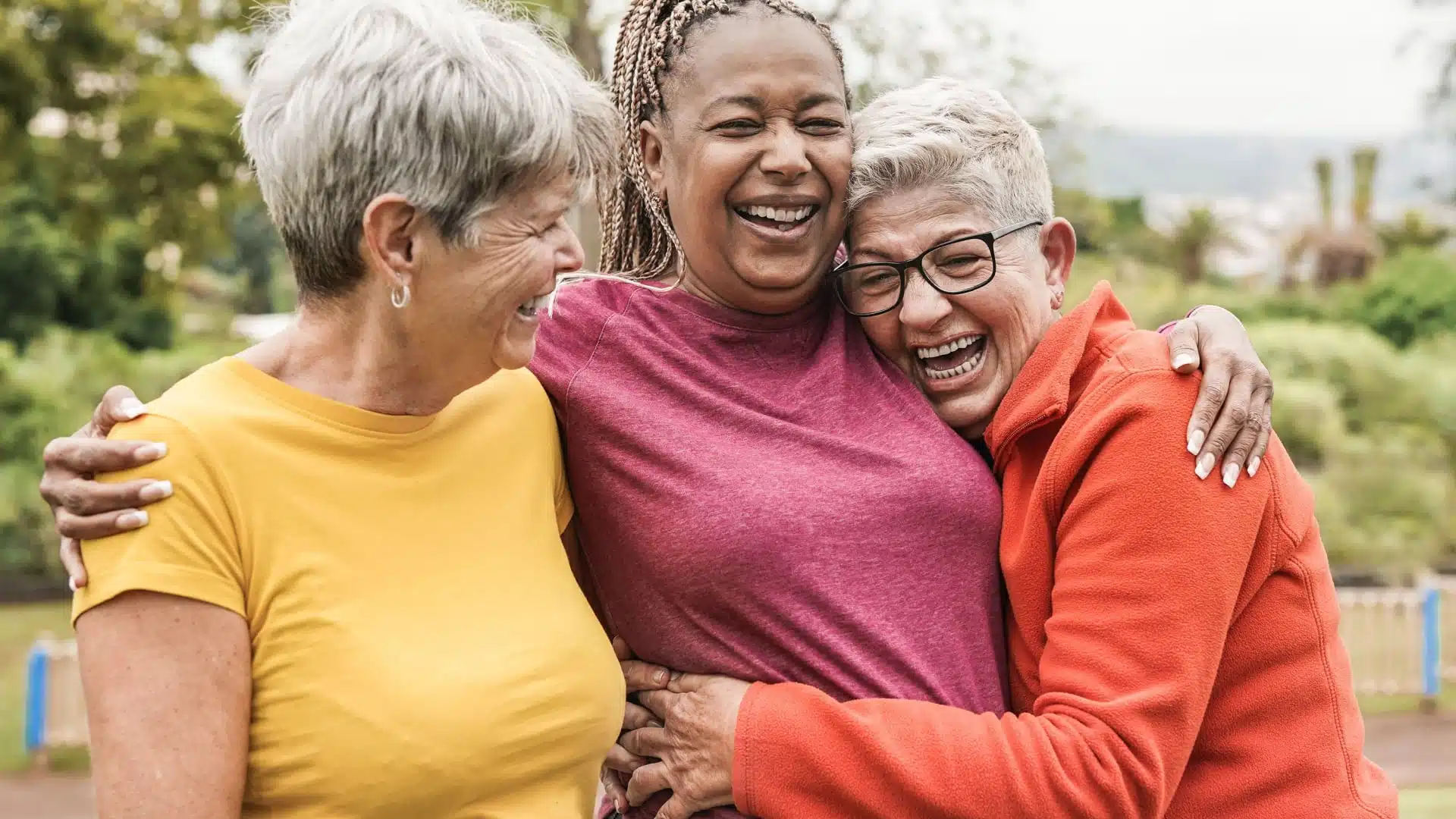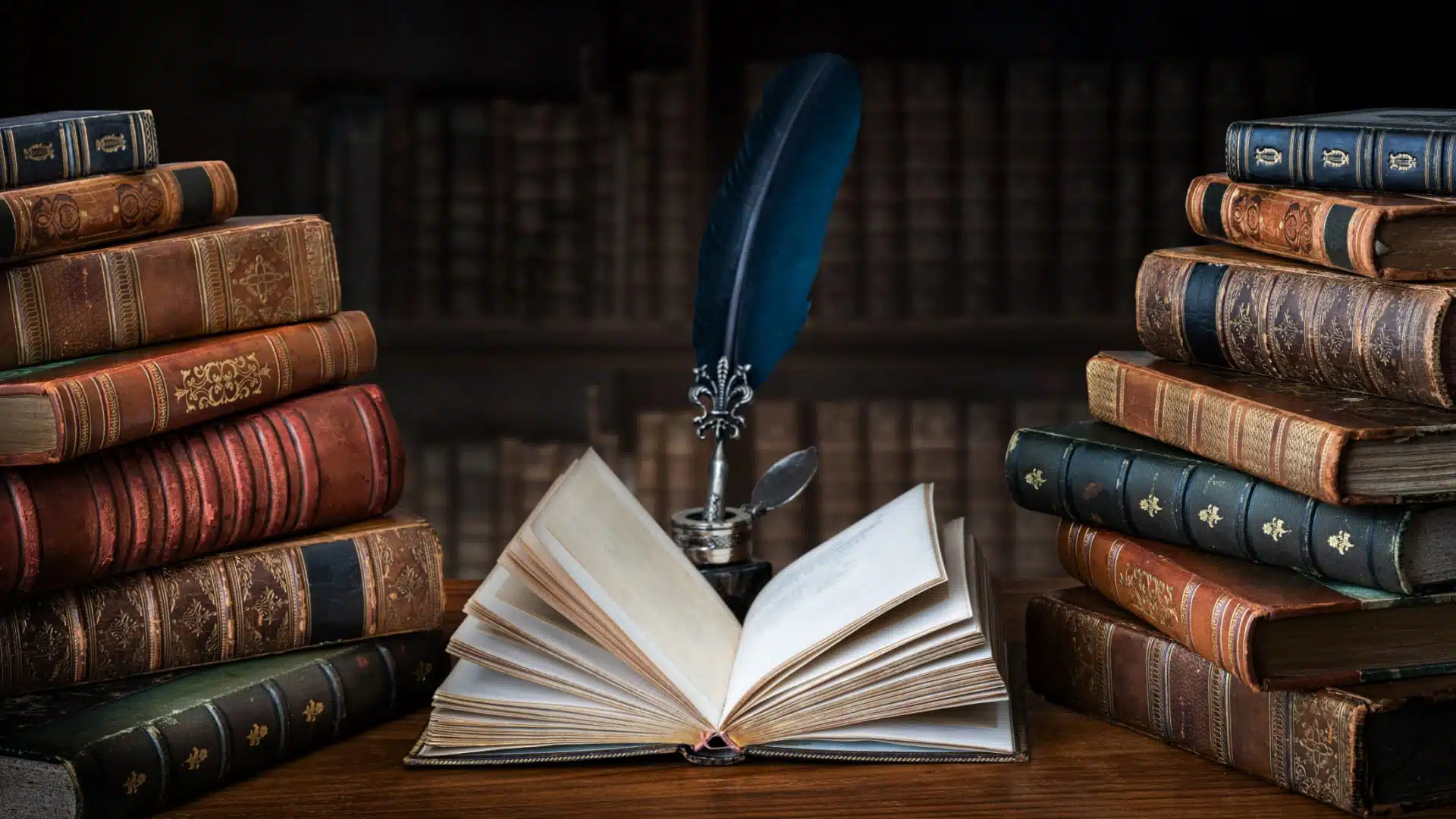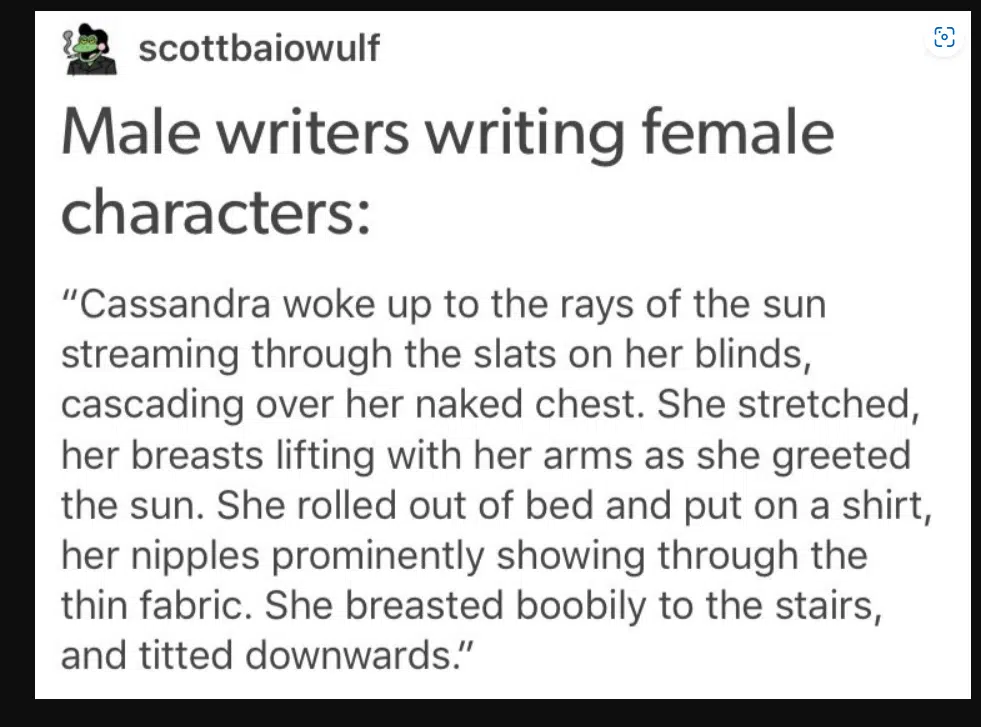Remember the Seinfeld episode where Jerry and George are working on their television show and leave out the Elaine character because they can’t figure out what she’d say?
It was a funny bit, but it’s all too true to life. Many male authors struggle to write compelling, three-dimensional female characters.
Men Writing Women
Men’s inability to properly write female characters is so common it spawned an entire subreddit dedicated to pointing out the hilarious (and awkward) attempts.
If you’re an author, you’ll want to avoid these common men writing women fails.
Chest Obsession

Men’s obsession with women’s chests is nowhere more apparent than in the pages of male author’s books.
These writers, unable to fathom that women aren’t as smitten with their breasts as they are, write every emotion as though the breasts play a major role. Female characters in books written by men are always conscious of how their breasts look and feel, and constantly looking at other women’s breasts. They’re folding their arms under their full breasts, sad when their friends died because their breasts died too, and feeling their breasts rub against their shirt in any action scene.
Real women don’t think of their breasts any more than any other body part.
Body Parts with Minds of Their Own
Not only are female characters obsessed with their breasts, but their breasts become characters of their own. They perk up in danger, droop when sad, and move around at whims based on what’s happening. ‘
It’s such a common fail it became a popular meme. The satirical men writing women fail originated on Tumblr, became famous on Twitter, and is now known as “She breasted boobily.”
“Cassandra woke up to the rays of the sun streaming through the slats on her blinds, cascading over her naked chest. She stretched, her breasts lifting with her arms as she greeted the sun. She rolled out of bed and put on a shirt, her nipples prominently showing through the thin fabric. She breasted boobily to the stairs, and titted downwards.”
That’s not how breasts work.
Not Like Other Girls
Female protagonists are often “different” from other girls in ways that make them better. Male protagonists get to be regular Joes, but ordinary girls typically aren’t “good” enough, so the female protagonists must be “different.”
The message seeps with misogyny, supporting the idea that women in general are “less than.” For people to take a woman seriously, she can’t be like a normal girl who enjoys feminine things. She must be a tomboy or “cool girl.” I love Buffy the Vampire Slayer because it throws this trope on it’s head, as Buffy’s biggest wish it to be a “normal girl.”
It’s All About Their Looks

Authors will grant male characters pages and pages of development related to their personality, backstory, and struggles but focus solely on a female character’s looks as if that’s her defining attribute.
She’s not even a character at this point, she’s merely decoration.
Describing Women
A woman’s looks are her defining attribute when she first enters a tale as well. Of course, any author must set the scene with a visual description, but many male offers linger far too long on a woman’s anatomy.
Some works have paragraphs describing her pert, perky, milky (insert adjectives here) breasts, while others focus on her entire body, but the vast majority of the descriptions related to how sexually attractive she is rather than any other vital characteristic.
Overthinking It
The Seinfeld episode highlighted a glaring flaw many male writers make: they overthink it. Gender is only one small part of a character, but many male writers focus too much on that, losing sight of the bigger picture.
Most women don’t think much about their gender unless the situation specifically calls for it (like in dating or gender discrimination). The vast majority of the time, we’re doing things as humans, not as women.
Passivity
Far too many women in fiction passively accept their fate while the men next to them battle for their lives. Although the fight, flight, or freeze response is genuine, men don’t have a monopoly on fighting, and women don’t automatically freeze.
The trope appears in all sorts of media, from Disney cartoons where she’s always waiting for her prince to save her, to romantic comedies where women must wait for men to make the first move.
When men write women, the women are rarely in charge of their own destinities. Things happen to them, they don’t make things happen.
Women’s Trauma
Male writers love writing about women’s trauma, but it’s typically only one type. It seems like every woman with trauma in male-written stories was sexually assaulted. The assault drives her character growth.
The trope appears in popular fiction like Game of Thrones and even young adult fiction like the popular A Court of Thorns and Roses.
Although sexual assault is horrifying, and a very real danger to women, it’s not the only thing that motivates women to grow.
Let women experience the full range of trauma that men get, like losing a loved one, a past injury, or a failure.
Women Moving Men Forward
One of the worst aspects of women in literature is that they rarely enjoy their own stories. Most women serve as a backdrop for men’s character development.
He fights to avenge a woman, a common trope where the woman only serves as cannon fodder for men.
Strong Woman = Hostile

Strong, capable women run the gambit of personality types in real life. Women can be strong and warm, strong and friendly, or strong and mean.
However, fictional women are typically shoehorned into the hostile box because, apparently, warmth is a weakness.
Any powerful businesswoman must be a horrible mean person, while male leaders get to be full people.
The Cool Girl
The movie Gone Girl turned the “cool girl” trope on its head. However, most male writers can’t seem to write any other character, thus promoting the “cool girl” as a toxic ideal.
The “cool girl” drinks beers, eats pizza, enjoys sports, and allows her boyfriend to walk all over her (but it’s somehow cute, and they love each other, so it’s okay!), all while looking fantastic.
Relationships
Most male writers can’t fathom a female character who’s not obsessed with marriage. Men get world-saving quests and hero journeys, but women’s ultimate motivations are usually the pursuit of romance.
Women deserve full stories of their own outside their relationships with men.
Babies
Women also must always want children. The Black Widow movies highlighted this by having the title character’s pivotal moment showcase that she can’t have children due to what was done to her.
While many women desire motherhood, not all women do, and it’s also not the ONLY thing most women strive for. Childfree women exist, as do women who realize saving the world is more important than raising a family.
Women are Actually People

Many male authors fail because they don’t see women as people but as some mysterious other. If they started writing women like they write people (AKA – Men), they’d get better results and more in-depth characters. But for some reason, they can’t seem to do that, and we get stuck with one-dimensional female characters who consistently follow a specific trope.
The problem is so ubiquitous in media that it feeds the misogyny machine. Nobody sees accurate portrayals of women anywhere, so people assume the fictional representations must be correct.
Use Creative Writing Prompts To Be a Better Writer

Want to be a better writer? Use prompts to boost your creativity and throw your expectations on their heads.
Here’s how to use creative writing prompts for better writing.


